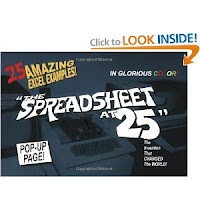Welcome to our
first interview feature of 2012! Bill Jelen is known as Mr. Excel, a
Microsoft Excel MVP, and the founder of, in my opinion, the best
online source to answer your Excel spreadsheet questions - the MrExcel website. Bill is also an author of many fabulous Excel books such as Microsoft Excel 2010 In Depth. I’d like
to thank Bill for taking the time out of his busy schedule to answer a
few of our questions.
Nick: Could you please tell us a little bit about yourself? When did you become known as Mr. Excel?
Bill: From
1986 - 2000, I worked in the accounting, finance, and operations
departments of an electronics company. I was the guy who knew how to get
data out of the mainframe, through a fourth generation reporting tool
and into Excel quickly. Whenever anyone at the company had an Excel
issue, they would come to me for a solution. I began writing Excel
macros to automate the common report requests. People kept telling me that I should write a book about Excel. I
would look for good ideas to put in the book from my co-workers, but
they frankly weren't generating enough questions.
Nick: What made you ultimately decide to launch the MrExcel website and forum?
Bill: I realized that if I launched a website and asked people to send me
their Excel questions, I would get the material for a book much more
quickly. It was back in 1998 that I registered
MrExcel.com.
It took a few days for people to find the site. I would post a new
article each week, which kept the content fresh and kept me higher in
the search engines (back then, I was thrilled to be in the top 10 when
you searched for Excel at the
Excite.com search engine.
Nick: Could you describe Microsoft’s MVP award and how you earned such a prestigious title?
Bill: Microsoft
names community members who provide a lot of free public help as a Most
Valuable Professional. Originally, the award criteria required you to
post via the newsgroups on Microsoft's site. Later, they opened the
award up to people who post at other sites, such as ExpertsExchange,
UtterAccess, MrExcel and more. I produce about 250 Excel podcasts each year, plus write articles for Strategic Finance and for
CFO.com.
I am never quite sure what it is that qualifies me for renewal of the
MVP award, but I will assume it is the free articles and podcasts that I
produce.
Last year, another Excel MVP wrote that he didn't see any benefit to
the MVP award and "retired" from the MVP program. I could not disagree
more. Once a year, the MVP's have the opportunity to travel to
Redmond Washington for the MVP Summit. During that time, you get about
two solid days with the project managers who actually decide the future
direction of Excel and Office. Now, I can not discuss anything specific
that I learn there, but I appreciate the chance to provide feedback on
new features and to understand what it coming in the next release of
Excel. As an example, I saw an early demo for PowerPivot and realized it
would be the greatest thing to hit Excel in 20 years. Consequently, my
books for Excel 2010 all feature content on PowerPivot. I even convinced
QUE to let me write an entire book explaining PowerPivot to the people
who spend their work lives in Excel.
Even between the MVP Summits, you have direct access to Microsoft
people who you meet at the Summit. How many people have been using Excel
and thought to themselves, "It would be better if Excel could do
_____". When I have those ideas, I can get them to the people who can
actually get them into Excel. Some of my ideas make it. Some do not. But
at least I know that I can get the ideas to the people who can evaluate
and decide if the idea is feasible.
Nick: Wow, that sounds pretty cool! I’ve seen Excel used as a 3D graphics engine before. In your
experience, what other interesting or unique uses for Excel have you
come across?
Bill: It always amazes me to see people use Excel for photos or graphics. I did a small project once for a lady in Kentucky who would design
hand-made quilts in Excel. The gridpaper aspect of the spreadsheet
allowed her to tile small quilt snippets together when planning a quilt.
Another
client has a folder with 2000 item pictures on each computer. The
report in Excel does some serious number crunching, finds the products
that are generally selling well in a particular region, but that are not
in stock at a given store. As the sales rep is meeting with the buyer
for the store, the Excel worksheet will display pictures of the regional
top 10 selling styles that the buyer should continue adding to the
store's inventory. The first 80% of the process is all standard
number-crunching in Excel. Taking the results and adding pictures on the
fly creates a targeted sales tool for each boutique.
Nick: That's very fascinating and just goes to show the power and versatility of Microsoft Excel! Thank again Bill for taking the time to answer a few of our questions. To learn more about Bill visit his website or check out one of his books (of which I've listed a few below):






